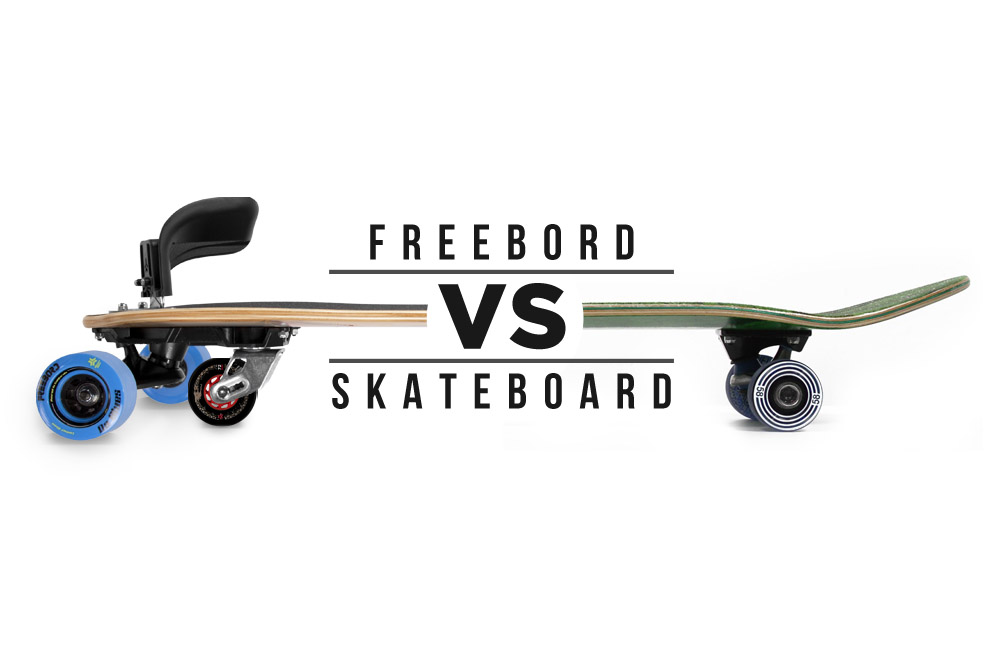FREEBORD vs. SKATEBOARD
[embedyt] http://www.youtube.com/watch?v=HKaG7ldIwUY[/embedyt]
TRUCKS & WHEELS
Unlike a skateboard, Freebords have six wheels: Four outside edge wheels and two castor (center) wheels located in the middle of the trucks.

A G3-R Truck – Notice the angled hangers designed for more control and stopping power.

G3-R Truck with Boro Center Center— The center wheel spins 360º and acts as the base of a snowboard.
CENTER WHEELS & ROCKER
The center wheels act as the base of a snowboard. They are slightly lower than the outer edge wheels and can rotate 360°, creating what’s known as “rocker”. This rocker is what gives riders the ability to slide laterally (like a snowboard) much easier than a longboard.* The outside edge wheels allow you to carve turns and control slides the same way as the edges of a snowboard.

Rocker

Center Rotation
CARVING & SLIDING
When leaning into turns and slides, Freebord riders can modulate how much of their weight is on their base (center wheels) and edges (outer wheels) and enjoy the full spectrum of carving, sliding, drifting, spinning and slashing motions possible on a snowboard.
**So how is sliding on a Freebord different than sliding on a longboard?
Sliding a skateboard or longboard requires forcing the wheels out of a normal turn—similar to skidding a car. Freebords allow the rider to distribute their weight to one edge at a time, just like snowboarding. This allows for a greater variety of slides as they are integrated into the turns and can be done at any speed in any direction.
BINDINGS
Located on the top of the board are two polycarbonate bindings with metal bases that allow the rider to adjust their individual stances. Freebord bindings serve the same purpose as snowboard bindings by giving the rider more control and leverage over the board. The biggest difference is that riders are not strapped into these bindings, so you can step on and off the board as needed.
Fun Fact: Freebords didn’t always have bindings. They were added when a rider who had lost his leg to cancer wanted to ride, so he slapped some skyhooks on and the rest is history. That rider was Tim Seward.
DECKS
Freebord decks are also quite different from your average skateboard deck.
- The overall shape is the biggest difference. Freebord decks have a narrower waist, allowing for more torsional flex which is essential when edging.
- On top of the waist, the deck is also a true twin tip (same on both ends), unlike most skateboards.
- Freebords do not have kick tails, although we have tried it out in the past.
FREEBORDING IS ALL ABOUT CONTROL
[embedyt] http://www.youtube.com/watch?v=StlARM3LSoU[/embedyt]
Imagine every run is now a snowboard run, having complete control opens up a new world of possibilities. This unique freedom lets you choose lines you’ve only ever dreamed of riding.
CONS
- Freebords were designed for downhill riding, so they aren’t ideal for flatland riding, but where there’s a will, there’s a way.
- Due to the similarity to snowboarding, Freebords have a much higher learning curve than a normal skateboard.
- It’s obviously not snow, so falls aren’t as forgiving, but unlike snowboarding, you, at least, have the ability to jump off the board if you need to.
PROS
- No other board comes close to giving you the amount of control you have on a Freebord.
- Stop on a dime.
- Freebords don’t get “Speed Wobbles” since the board requires you to deliberately switch from heel edge to toe edge, it’s immune to the wheel-set “Hunting Oscillation.” (You can read more about that here)
- Snowboard all year long once you buy your lift ticket for life.
Buy A Complete
Other FAQ:
Freebord vs. Skateboard
What Size Freebord Should I Get?
How Hard Is It?
Can You Ride It On Flatland?
Maple vs. Bamboo
How long do the wheels last?
How do I get on the Freebord Team?
How to tune your setup.
Master FAQ list




